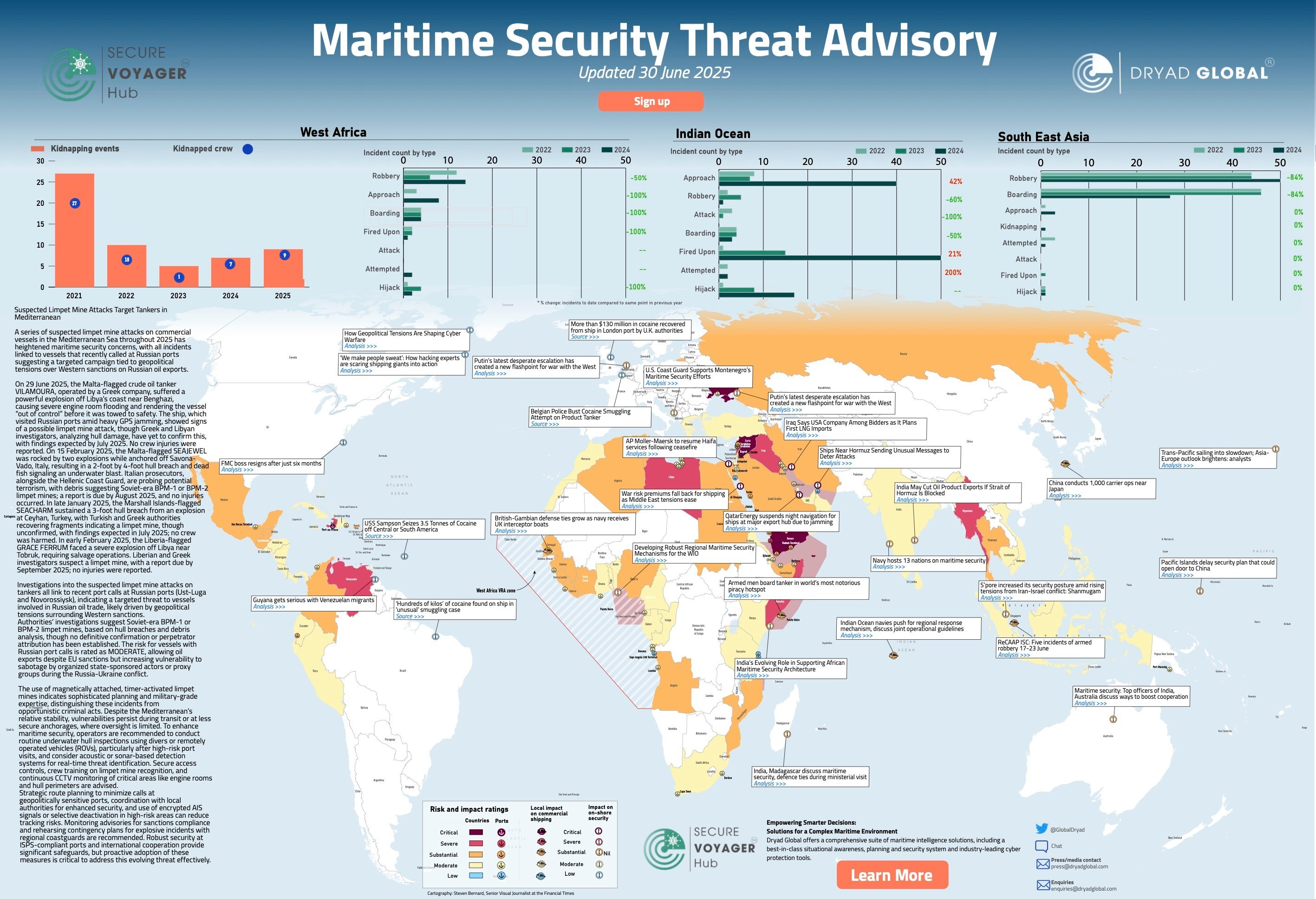A wave of suspected underwater explosive attacks targeting commercial oil tankers in the Mediterranean throughout 2025 has intensified maritime security concerns across the region.
Dryad Global’s June MSTA identifies a clear pattern: vessels recently calling at Russian ports are being struck by suspected limpet mines, raising fears of a deliberate sabotage campaign linked to geopolitical fallout from Western sanctions on Russian oil exports.
Latest Incident: Explosion off Libya
On 29 June, the Malta-flagged crude oil tanker VILAMOURA, operated by a Greek firm, suffered a significant blast off the Libyan coast near Benghazi. The explosion caused severe engine room flooding, rendering the vessel uncontrollable until towed to safety. Early assessments point to a possible limpet mine, although official confirmation from Greek and Libyan investigators is expected by July.
This is not an isolated case.
A Pattern of Attacks Emerges
-
15 February – SEAJEWEL (Malta-flagged): Two explosions while anchored near Savona-Vado, Italy, resulted in a 2x4-foot hull breach. Authorities are investigating the use of Soviet-era BPM-1 or BPM-2 limpet mines.
-
Late January – SEACHARM (Marshall Islands-flagged): A 3-foot hull breach near Ceyhan, Turkey. Recovered debris suggests a limpet mine was used.
-
Early February – GRACE FERRUM (Liberia-flagged): Severely damaged near Tobruk, Libya, with salvage operations required.
Crucially, all vessels had recently visited Russian ports such as Ust-Luga or Novorossiysk, suggesting a focused campaign against vessels involved in sanctioned Russian energy trade.
What’s Driving the Threat?
While investigations are ongoing, Dryad assesses the risk to be MODERATE for vessels calling at Russian ports. The attacks demonstrate military-grade sophistication—these are not opportunistic acts but highly targeted operations, potentially involving state-sponsored actors or proxy groups amid the ongoing Russia-Ukraine conflict.
The suspected use of magnetically attached, timer-activated limpet mines indicates advanced planning and intent to disrupt energy flows and pressure Western-aligned operators.
Try Secure Voyager Hub by Dryad Global now:
Mitigating the Risk: Operational Recommendations
To navigate this emerging threat environment, Dryad Global recommends the following for commercial shipping operators:
-
Underwater Inspections: Deploy divers or remotely operated vehicles (ROVs) after high-risk port calls.
-
Detection Systems: Acoustic or sonar-based sensors can assist in identifying submerged threats.
-
Crew Preparedness: Train crews to recognise limpet mine indicators and maintain active surveillance using CCTV around engine rooms and hull areas.
-
Strategic Route Planning: Avoid geopolitical hotspots where feasible; work closely with local maritime authorities.
-
AIS Management: Consider encrypted AIS or selective signal deactivation in high-risk zones to reduce traceability.
-
Compliance and Contingency: Stay current on sanctions-related advisories and rehearse incident response procedures with local coastguards.
Despite the Mediterranean’s reputation for relative stability, this new wave of attacks reveals vulnerabilities in anchorage and transit zones. Enhanced port security, inter-agency cooperation, and strategic intelligence sharing will be key to protecting maritime assets in the months ahead.





